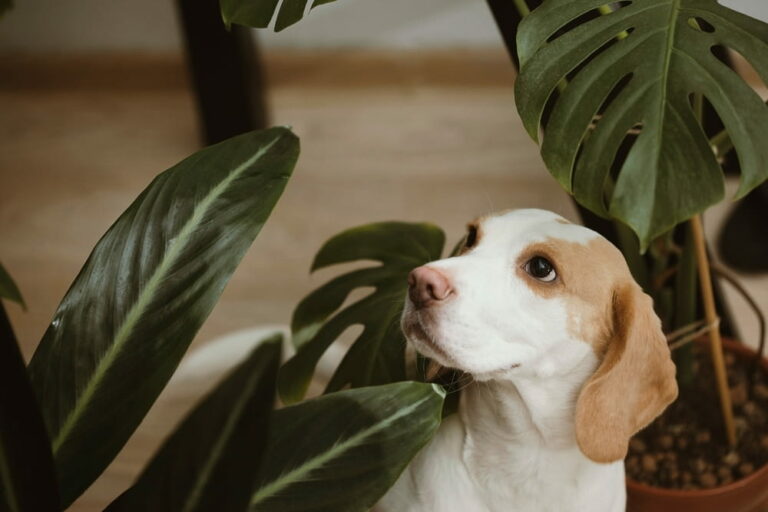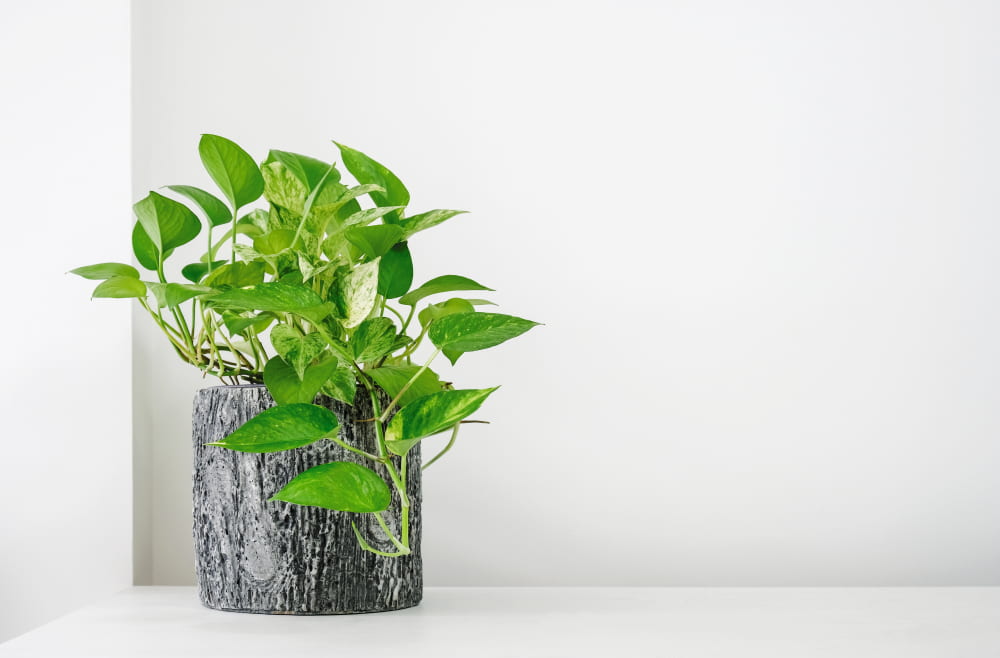Are These Plants Toxic to Dogs? A Look at Common Varieties

Houseplants are all the rage these days. In the past few years, sales have nearly doubled to $1.7 billion. On top of giving you an Insta-worthy space, a little greenery could also help ease stress and boost your mood—perks we can all use.
One problem: Many of the most popular varieties are also poisonous plants for dogs (womp). Besides a broken pot and mouth full of dirt, symptoms of gastrointestinal distress like drooling, vomiting, or diarrhea could indicate your pup’s gotten into something, says Dr. Bob Poppenga, head of toxicology at the California Animal Health and Food Safety Laboratory in the School of Veterinary Medicine at UC-Davis.
That said, a little bite is unlikely to result in an emergency situation or a rush to the veterinarian’s office unless we’re talking about particularly dangerous plants like the sago palm or oleander, he says.
If you’re worried about a serious exposure to houseplants toxic to dogs or another poisonous substance, immediately contact your veterinarian or call the ASPCA Animal Poison Control Center (APCC) 24-hour emergency poison hotline at 1-888-426-4435.
Otherwise? Learn what plants are toxic to dogs, which nontoxic plants veterinarians recommend, and how to keep your pup safe, no matter your taste in houseplants.
Which Plants Are Toxic to Dogs? Safe and Unsafe Houseplants
Numerous chemicals can make certain houseplants toxic to dogs based on the way they affect different organ systems, says Dr. Judy Morgan, a New Jersey-based veterinarian specializing in integrative medicine.
For example, many common indoor plants contain calcium oxalate crystals. When bitten into, these crystals can irritate a dog’s mouth and gastrointestinal (GI) tract, and, in very rare cases, cause swelling and trouble breathing. For these reasons, it’s best to opt for nontoxic plants when you can and to store potentially toxic plants out of reach (more on that later!).
Here, learn whether your choice of houseplant is a friend or foe to canines.
Are Snake Plants Toxic to Dogs?

Snake plants, a.k.a. mother-in-law’s tongue, are hardy succulents with sharp, spiky leaves famous for growing just about anywhere. But because they contain saponins, they’re considered toxic to dogs and could cause drooling, nausea, vomiting, or diarrhea when ingested.
Are Spider Plants Toxic to Dogs?

Thankfully, the most Googled plant of 2020 is only considered mildly toxic to dogs (and cats!), which means there’s a risk for *a little* GI irritation if eaten. All in all, veterinarians say spider plants are generally safe for our canine friends.
Are ZZ Plants Safe for Dogs?

The ZZ plant (Zamioculcas zamiifolia) is a South African plant with dark green leaves that’s especially popular for its ability to tolerate low-light conditions, drought, and neglect, says Desiree Thomson, a gardening and plants expert at Gardening Services London.
Unfortunately, its sap does contain calcium oxalate crystals—which means it’s on the toxic houseplants list.
Are Aloe Plants Toxic to Dogs?

Because aloe contains saponins and anthraquinones, it’s toxic to dogs and could cause vomiting or diarrhea if eaten. Surprised? We were, too! “One plant that many would think would be non-toxic because of its healing properties is the Aloe vera plant,” says Lisa Steinkopf, a.k.a. “The Houseplant Guru” and author of Houseplant Party and Grow in the Dark.
Are Jade Plants Safe for Dogs?

A staple of many mini planters, the jade plant (a.k.a. baby jade or dwarf rubber plant) is a great low-maintenance succulent, but it’s not so friendly to Fido, says Thomson. While it’s not known exactly what substances make jade plants dangerous for dogs, exposure can cause mild GI distress and, in rare cases, lethargy, tremors, coordination issues, or an elevated heart rate.
Are Rubber Plants Toxic to Dogs?

Rubber plants are tricky because some are safe for dogs (like the American rubber plant), while others aren’t (like Japanese, Chinese, and Indian rubber plants, to name a few). Those on the toxic list may cause vomiting, low mood, or a lack of coordination in dogs.
Are Monstera Plants Toxic to Dogs?

With its tropical flare and lush look, the Monstera deliciosa, a.k.a. Swiss cheese plant or cutleaf philodendron, is on just about every plant lover’s wishlist. Unfortunately, they’re also on the plants dangerous for dogs list. Philodendrons can give dogs a nasty surprise should they try to nibble on it. This is due to irritating calcium oxalate crystals, says Thomson.
Are Pothos Plants Toxic to Dogs?

If you’ve got a curious puppy, this is another plant you might want to steer clear of, says Steinkopf. The pothos plant, also known as Devil’s ivy since it’s nearly *impossible* to kill, grows wild even with very little light. However, it also contains calcium oxalate crystals and should be kept away from dogs.
List of Poisonous Plants for Dogs
Along with the Sago palm and those listed above, other houseplants toxic for dogs include:
- Arrowhead vine
- Asparagus fern
- Burro’s tail
- Chinese evergreen
- Christmas cactus
- Cycads such as the fern palm
- Dumbcane (Dieffenbachia)
- Elephant’s ear
- Eucalyptus
- Some lilies such as the calla, clivia, and peace lily
- Philodendrons
- Umbrella tree
If you believe your dog has consumed or chewed on any of these plants, call your veterinarian and watch your dog closely for symptoms. Your veterinarian may recommend a checkup or a trip to the emergency room, depending on the type of plant and how much your dog consumed.
Safe Houseplants for Dogs
While keeping your dog away from potentially harmful plants might mean removing a few from your cart, you’ve still got plenty of options including stylish succulents, large floor plants, and colorful exotics.
Here’s a roundup of veterinarian-approved houseplants that are safe for dogs:
- African violet
- Areca palm
- Blue echeveria
- Blushing bromeliad
- Boston fern
- Calathea
- Cast iron plant
- Zebra haworthia
- Peperomia
- Phalaenopsis orchid (moon orchid)
- Pilea
- Parlor palm
- Ponytail palm
Dogs and Plants: Safety Tips to Follow

The best way to keep your canine safe is to avoid plants dangerous for dogs in the first place, says Dr. Poppenga. However, it’s okay to have certain not-so-dog-friendly houseplants like dumbcane or philodendron if they’re kept out of reach, he adds.
Here’s how to dog-proof your urban jungle:
Keep plants out of reach. Place houseplants toxic to dogs on high shelves, in hanging baskets, or behind baby gates.
Use a deterrent. Spray plants and pots with a natural deterrent such as lemon juice, vinegar, or diluted hot pepper (capsaicin).
Clean up fallen leaves. Promptly pick up any shed leaves before your dog can eat them.
Designate a dog-free plant room. For particularly curious or hungry canines, consider keeping houseplants in a no-dogs-allowed room.
As you continue to add new plants to your family, remember to research them before you bring them into your home. All it takes is a quick search to figure out if you’ve found a good fit.









